Overview

Personal Project
Into the Chambers


VR

1

6 months
Tasks & Responsibilities
-
Technical Game Design
-
VR Integration
-
Character Movement, Interactions & Animations
-
Weapon & Difficulty Design
-
AI Behavior
-
Sound Design
-
-
General Game Design
-
Documentation & Project Management
-
Overall Game Balance & Quality Assurance
-
UX Research
-
-
Level Design
-
Floor Planning
-
Designed 2 identical maps with different aesthetics, using modular assets & props
-
-
Live Playtest with more than 50 people
-
Video Editing
Into the Chambers - Gameplay Trailer
Into the Chambers is a solo survival horror game set in an underground dungeon filled by various types of Orcs. This project was done during my last semester at SAE Athens Institute for my Thesis. The purpose of this game was to evaluate the player's immersion in two different graphic representations, developed with the same techniques, regarding the Game and Level Design.
The game was developed in Unity Engine for VR platforms, using Oculus Integration. In terms of gameplay mechanics, players must explore and scavenge for weapons, as well as use the environmental elements and character's attributes, in order to escape the dungeon.
On top of the development, the evaluation of player's experience was made through live playtesting, surveys and Q&A of over 20 people with different gaming background experiences.
Technical Game Design
VR Integration
As I already had experience developing games on VR Platforms, I used the Oculus Integration in Unity Engine, in order to develop all the necessary gameplay mechanics. On top of that, VR was the perfect perspective for the evaluation of player's immersion, because based on different kinds of sources, players will more likely enter the "Flow Channel" in games using this technology.
Character Movement, Interactions & Animations
The game was designed in a way that it would be fun and accessible for different gaming background experiences. That led me to a choice to develop basic player mechanics like, walking, running, jumping, climbing and interactions with different kinds of objects, like weapons and potions.
Furthermore, due to the Finger Tracking technology of the Oculus system, I created different animations for the hands of the player, depending on the object the user is holding. On top of this system, every interaction or trigger enabled Haptic Feedbacks. That helped a lot players who had no or less experience in VR games, to familiarize themselves with the gameplay mechanics and have an overall smoother experience.
Like most of Survival Horror Games, a simple Inventory System was not missing from Into the Chambers. More specifically, players have four slots on their belt to store items like weapons and potions for later stages in the game. That led them to have freedom in their approach to each state of the game.
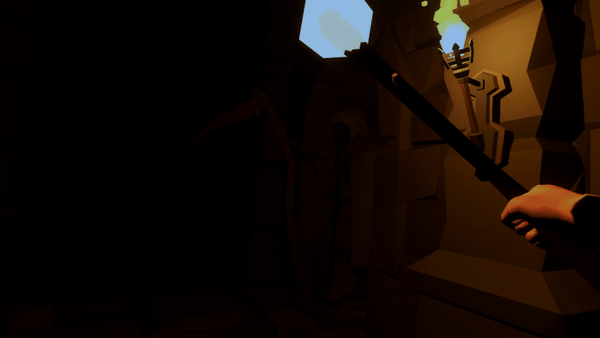

(1) Walking Movement - (2) Climbing Mechanic
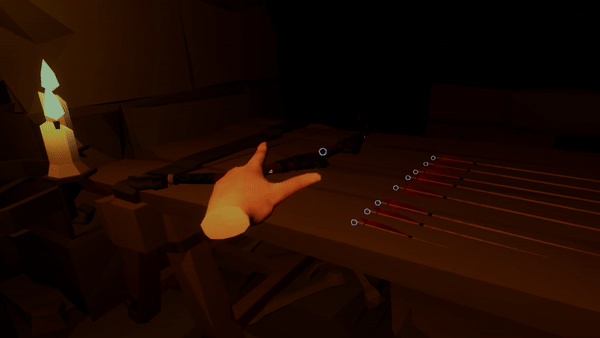
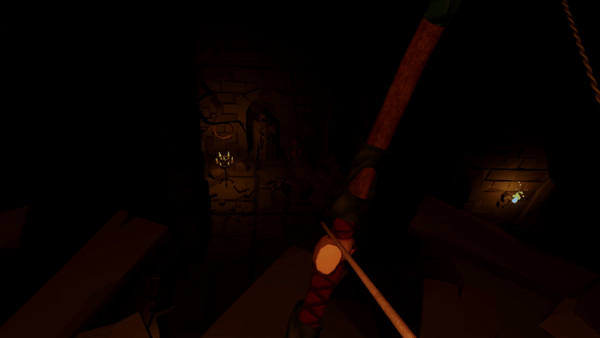
(1) Interact mechanic with a bow - (2) Attack mechanic with a bow
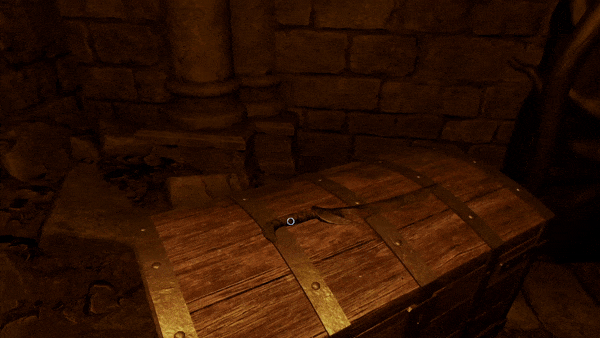
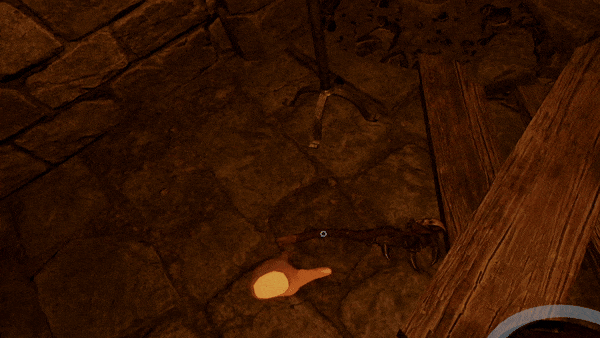
(1) Storing a sword in player's inventory - (2) Interacting & Inspecting a club
Weapon & Difficulty Design
To make the game more entertaining and promote the sense of exploration, each weapon was designed differently and was separated into two types: melee and ranged. Each weapon has its own damage output and has been placed strategically in the levels in order to be obtained by the players at different stages of the game. This decision allows the players to fight their way out with different approaches, even with bare hands.
Due to that, the more the players were exploring the dungeons, the harder the game and the enemies would become. That led them to think strategically about their moves for each stage of the game, by either fighting any enemy they would encounter or even carefully avoiding them to bypass each level.
Lastly, the game have no checkpoints and was designed with a Permadeath mechanic, which made them lose all their progress in case they died. The reason I chose this particular system was because it created a feeling of a bigger sense of anxiety and concern during the fights, affecting their immersion dramatically.
AI Behavior
In terms of the enemies, I developed the AI behavior with simple states like, idle, patrol, alert, chase, light attack, heavy attack and death. Furthermore, there were three types of enemies: light melee, heavy melee and ranged. Each of the enemies had their own stats of health and damage output, differentiating every approach from the players' perspective. Lastly, each enemy had different animations exported from Mixamo and tweaked to match their personality, including a ragdoll death animation which was made inside the Unity Engine.
As stated, each stage of the game is different from the others. The game was designed in a way that let the players learn the combat basics from the start and was getting harder at later ones, due to quality and quantity of the enemies.
Lastly, as any other survival horror game, I created different jumpscares at particular points in the game, with environmental elements or evil spirits in the dungeon. In between the fighting and exploration, I wanted to make the players feel vulnerable to the environment and be always alert of what was happening in the game.

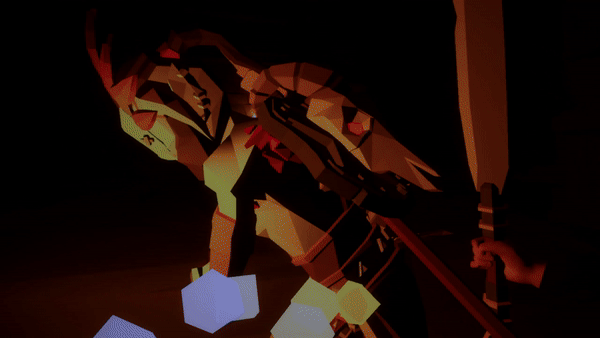
(1) Chase & Light attack from one of the enemies - (2) Heavy attack from one of the enemies
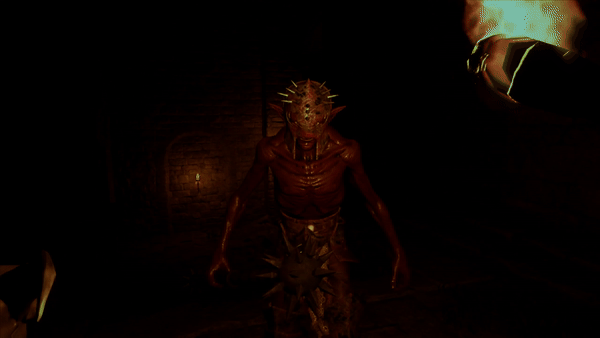

(1) Ragdoll Death animation - (2) Jumpscare triggering
Sound Design & Lack of UI
Like any other horror game, this project was heavily focused on sound effects that would affect the player's immersion. I used different kinds of pre-made SFX from other creators and mixed them together by coding them into the Audio Mixer of Unity Engine, to create a desirable horror ambience. These SFX varied from environmental elements like, different echoes from room to room, wind, rain, wood creaks, ghosting and whispering sounds etc. These sounds were generated randomly in each area and differed for each playthrough, in order to make a more dynamic environment.
In addition, I developed a system for different footstep SFX for the main character and the enemies, depending on the surface they are stepping into. This system included SFX like grass, wood, stone and mud surface.
Lastly, each enemy had their own unique sounds, including attacking sounds, growls, impacts etc.
In terms of the UI design, I decided to have only the essential ones, like the inventory rings near the player's body in order to guide them when they wanted to store an item, as well as a simple death UI, that would lead them to the main menu scene or restart the level. This decision was made after researching from sources that UI elements in games could often negatively affect the immersion of the user. Overall, I tried to implement all the necessary guidance for the users with the essentials. For example, other than the inventory rings, the health of the player is indicated with Post Process Effects and heartbeat sounds that would indicate how vulnerable they are.
General Game Design
Documentation & Project Management
From the initial pitch to creating the Game Design Document, every step of the process was a testament to my passion for game development. The game's mechanics were carefully developed to enhance the horror experience, as well as each level design of the game.
To ensure the smooth execution of the project, I used various project management tools, such as Gantt Charts and Trello Boards. These tools allowed me to track progress, allocate resources efficiently and maintain a clear overview of tasks at hand. Lastly, GitHub serves as a base for version control, facilitating seamless workflow on my daily tasks.

Gantt Chart overview
Overall Game Balance & Quality Assurance
Another ongoing task was to ensure that no single element would break players' immersion. Plenty of internal iterations happened during the development of the game, as well as after conducting the live playtests and surveys. Factors like movement flow, weapon interaction, AI attributes, damage output and level design were tweaked after personal playthroughs and playtesting.
Lastly, I had to identify and document any issues or bugs that could negatively impact player experience before the playtesting period, or else the whole thesis purpose would be pointless. Apparently, there were no specific bugs reported during that period and the data collection from the users was successful.
UX Research
During my thesis project, I investigated the impact of different art styles on player immersion within the context of a survival horror game. The central question driving my research was whether varying visual aesthetics could influence players' immersion and engagement with the game world.
To explore this question, I conducted a series of UX research activities, including surveys and live playtests from diverse gaming backgrounds. These surveys assessed various aspects of immersion, such as emotional involvement, spatial presence and overall satisfaction.
In parallel, live playtests provided insights into how players interacted with the game environment and responded to each art style in real-time. By observing player behavior and collecting direct feedback during these playtests, I gained deeper insights into the subjective experiences of immersion and the factors influencing players' engagement.
Ultimately, my project is focused on the ways in which different art styles can impact player immersion, highlighting the importance of game design decisions in creating VR gaming experiences.
Level Design

In this project, the level design also played a crucial role in exploring the impact of different art styles on player immersion. To accomplish this, I created two identical dungeon maps, each crafted to offer a horror experience, with the only difference being the art style employed.
I started level designing the first map, using modular assets from the Unity Asset store, which featured realistic textures and graphics, to evoke a sense of eerie realism. From the caves to every room and corridor, each area created a sense of captivity and isolation, as most of survival horror games do.
In contrast, the second dungeon map employed low-poly 3D textures and graphics, embracing a stylized aesthetic. Despite its simplified visual style, this map also createda haunting atmosphere. The use of stylization served to heighten the game's immersion, inviting players to explore the dark and mysterious depths of the dungeon.
Identical Level Layouts (1) - 3D Low Poly (2) - Realistic
In designing the level of the game, I had to simultaneously balance the gameplay elements and the difficulty curves as well. On the first section of the map, I wanted the players to learn the basic movement and interaction of the game, without immediately feeling threatened. By interacting and holding a torchlight, they could guide through a long cave and familiarize themselves with the environment and the VR technology as well, depending on their gaming expertise. At the end of the cave, players can find their first weapon and potion, as well as their first enemy encounter. Players could make their choice by either fighting their way through or avoiding the enemy.
Soon after, players had to make their first choice, by picking an optional path or moving forward. As most of the survival games are made with a linear layout and optional paths, the map was designed in a way that sometimes paths could lead to dead ends or hidden passages. However, in each case, the game was designed in a way that would reward the players who spent more time exploring, with better weapons and potions. The overall flow of the game was following the same recipe as the above, with more and stronger enemies, traps and jumpscares, leading the players deeper in the dungeons.


Identical in-game image of a trap corridor (1) - Realistic (2) - Low Poly


Identical in-game image of a prison corridor (1) - Realistic (2) - Low Poly
Overall, by creating two parallel maps within the game, I sought to demonstrate how the choice of art style can profoundly impact the player's perception and emotional response. Whether traversing the photorealistic corridors of one dungeon or navigating the stylized landscapes of the other, players are immersed in almost the same way in both graphical representations.